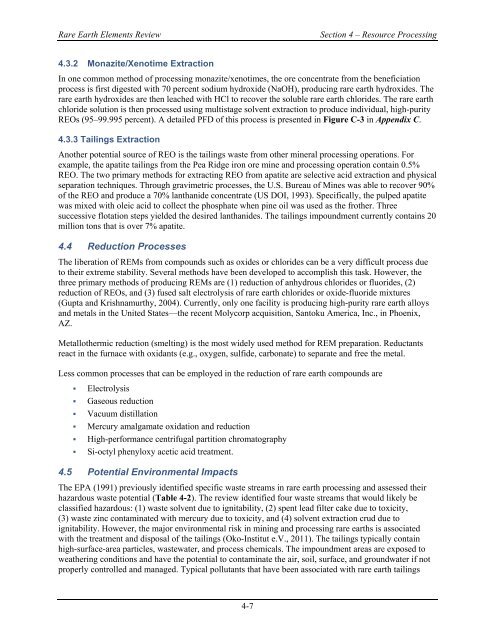Rare Earth Elements: A Review of Production, Processing ...
Rare Earth Elements: A Review of Production, Processing ...
Rare Earth Elements: A Review of Production, Processing ...
You also want an ePaper? Increase the reach of your titles
YUMPU automatically turns print PDFs into web optimized ePapers that Google loves.
<strong>Rare</strong> <strong>Earth</strong> <strong>Elements</strong> <strong>Review</strong> Section 4 – Resource <strong>Processing</strong><br />
4.3.2 Monazite/Xenotime Extraction<br />
In one common method <strong>of</strong> processing monazite/xenotimes, the ore concentrate from the beneficiation<br />
process is first digested with 70 percent sodium hydroxide (NaOH), producing rare earth hydroxides. The<br />
rare earth hydroxides are then leached with HCl to recover the soluble rare earth chlorides. The rare earth<br />
chloride solution is then processed using multistage solvent extraction to produce individual, high-purity<br />
REOs (95–99.995 percent). A detailed PFD <strong>of</strong> this process is presented in Figure C-3 in Appendix C.<br />
4.3.3 Tailings Extraction<br />
Another potential source <strong>of</strong> REO is the tailings waste from other mineral processing operations. For<br />
example, the apatite tailings from the Pea Ridge iron ore mine and processing operation contain 0.5%<br />
REO. The two primary methods for extracting REO from apatite are selective acid extraction and physical<br />
separation techniques. Through gravimetric processes, the U.S. Bureau <strong>of</strong> Mines was able to recover 90%<br />
<strong>of</strong> the REO and produce a 70% lanthanide concentrate (US DOI, 1993). Specifically, the pulped apatite<br />
was mixed with oleic acid to collect the phosphate when pine oil was used as the frother. Three<br />
successive flotation steps yielded the desired lanthanides. The tailings impoundment currently contains 20<br />
million tons that is over 7% apatite.<br />
4.4 Reduction Processes<br />
The liberation <strong>of</strong> REMs from compounds such as oxides or chlorides can be a very difficult process due<br />
to their extreme stability. Several methods have been developed to accomplish this task. However, the<br />
three primary methods <strong>of</strong> producing REMs are (1) reduction <strong>of</strong> anhydrous chlorides or fluorides, (2)<br />
reduction <strong>of</strong> REOs, and (3) fused salt electrolysis <strong>of</strong> rare earth chlorides or oxide-fluoride mixtures<br />
(Gupta and Krishnamurthy, 2004). Currently, only one facility is producing high-purity rare earth alloys<br />
and metals in the United States—the recent Molycorp acquisition, Santoku America, Inc., in Phoenix,<br />
AZ.<br />
Metallothermic reduction (smelting) is the most widely used method for REM preparation. Reductants<br />
react in the furnace with oxidants (e.g., oxygen, sulfide, carbonate) to separate and free the metal.<br />
Less common processes that can be employed in the reduction <strong>of</strong> rare earth compounds are<br />
� Electrolysis<br />
� Gaseous reduction<br />
� Vacuum distillation<br />
� Mercury amalgamate oxidation and reduction<br />
� High-performance centrifugal partition chromatography<br />
� Si-octyl phenyloxy acetic acid treatment.<br />
4.5 Potential Environmental Impacts<br />
The EPA (1991) previously identified specific waste streams in rare earth processing and assessed their<br />
hazardous waste potential (Table 4-2). The review identified four waste streams that would likely be<br />
classified hazardous: (1) waste solvent due to ignitability, (2) spent lead filter cake due to toxicity,<br />
(3) waste zinc contaminated with mercury due to toxicity, and (4) solvent extraction crud due to<br />
ignitability. However, the major environmental risk in mining and processing rare earths is associated<br />
with the treatment and disposal <strong>of</strong> the tailings (Oko-Institut e.V., 2011). The tailings typically contain<br />
high-surface-area particles, wastewater, and process chemicals. The impoundment areas are exposed to<br />
weathering conditions and have the potential to contaminate the air, soil, surface, and groundwater if not<br />
properly controlled and managed. Typical pollutants that have been associated with rare earth tailings<br />
4-7















